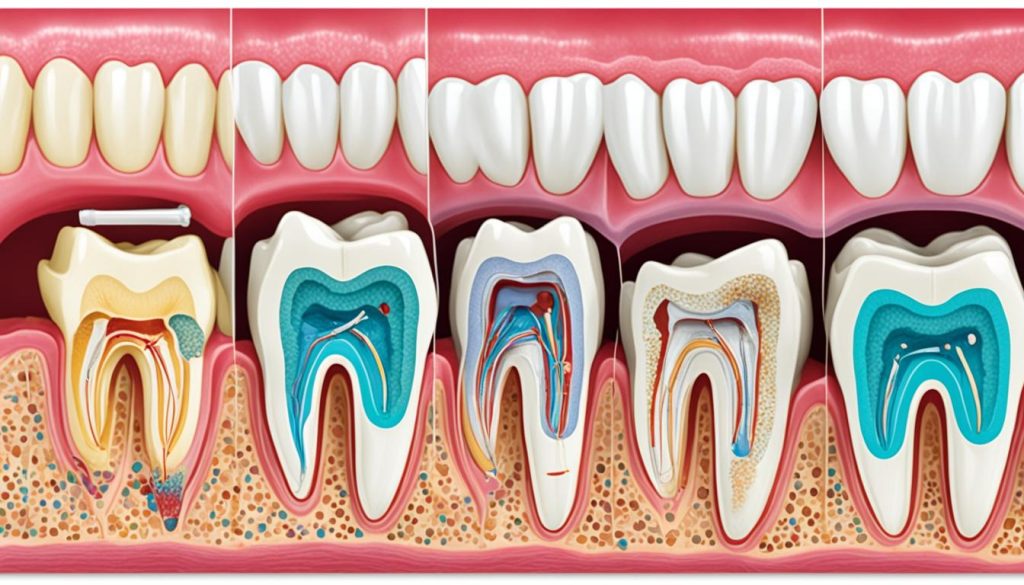Have you ever wondered how long it takes for a cavity to form? Understanding the timeline of cavity development is crucial in maintaining optimal oral health. Factors such as weaker enamel, poor dental hygiene, an unhealthy diet high in sugar, and tobacco use can accelerate the formation of cavities. However, with proper oral care habits, the progression of cavities can be slowed down.
How Long Does It Take for a Cavity to Form?
Cavity development can vary from person to person, making it challenging to determine an exact timeframe. However, neglecting oral healthcare habits can lead to permanent enamel damage. Therefore, it is essential to be aware of the signs of cavity formation and take action early to prevent further damage.
In this article, we will explore the factors affecting cavity formation, the timeline of cavity development, recognizing early signs of cavities, treating cavities, preventing cavities, the importance of regular dental visits, and more. Stay tuned to learn everything you need to know about cavity formation and how to protect your teeth from dental decay.
Factors Affecting Cavity Formation
The speed at which a cavity forms can vary depending on several factors. Weaker enamel, such as in children under six years old, is more susceptible to decay and can lead to faster cavity formation. Poor dental hygiene, an unhealthy diet high in sugar, tobacco use, and teeth grinding can also increase the risk of cavities. The rate of decay and enamel erosion varies from person to person, making it important to maintain good oral health habits to prevent cavities.

Timeline of Cavity Formation
When it comes to the development of cavities, the timeline can vary depending on several factors. It is difficult to determine an exact timeframe for cavity formation, as it is influenced by various variables, as mentioned earlier. While some cavities can take years to form, others can develop at a faster pace.
With proper oral care habits and regular visits to the dentist, cavity formation can be significantly slowed down. However, neglecting oral hygiene practices can accelerate the process, leading to the formation of cavities in a matter of months.
It’s essential to note that the progression of decay is often slow during the early stages. However, if proper oral care is neglected, the decay can progress rapidly. Therefore, maintaining good oral hygiene practices and seeking timely dental treatment are vital in preventing the rapid development and spread of cavities.
The Role of Oral Hygiene
A consistent oral care routine, including brushing your teeth at least twice a day with fluoride toothpaste, flossing daily, and using a fluoride mouthwash, can help slow down the progression of cavity formation. Additionally, regular dental check-ups every six months allow your dentist to detect early signs of decay and provide appropriate treatment to prevent further damage.
| Factors | Average Time for Cavity Formation |
|---|---|
| Proper oral care habits, including regular brushing, flossing, and dental visits | Years |
| Poor oral hygiene, neglecting oral care practices | Months |
The table above provides a general overview of the average time it takes for cavities to develop based on different factors.
It’s important to remember that every individual’s oral health is unique, and the rate at which cavities form can vary. By prioritizing oral care and seeking professional guidance, you can effectively manage and prevent the progression of cavities, ensuring long-term dental health.
Recognizing Early Signs of Cavities
Recognizing the early signs of cavities is crucial in preventing further damage. Common symptoms include:
- Sensitivity to hot and cold
- Sensitivity to sweets
- Tooth pain
- Visible holes or pits in the teeth
If you experience any of these symptoms, it is important to seek dental treatment as soon as possible to prevent the progression of decay and further damage to the tooth structure.

| Early Signs of Cavities | Symptoms | |
|---|---|---|
| Tooth Decay | Sensitivity | – Hot and cold |
| – Sweets | ||
| Tooth Pain | ||
| Holes or Pits | ||
Treating Cavities
When it comes to treating cavities, the approach taken depends on the severity of the decay. Here are the typical treatment options:
Filling
If the cavity is minor and in the early stages of development, a filling is often the preferred treatment. During this procedure, the dentist will remove the decayed portion of the tooth and fill it with a tooth-colored material, such as composite resin or amalgam. This not only stops further decay but also restores the tooth’s function and aesthetics.
Dental Crown
For larger cavities or instances where the decay has weakened the tooth structure, a dental crown may be necessary. A crown is a cap that covers the entire tooth, providing support and preventing the decay from spreading. This option is beneficial when a significant portion of the tooth needs to be replaced, ensuring its long-term durability and functionality.
Root Canal
When the decay reaches the pulp of the tooth, a root canal procedure may be required. This treatment involves removing the infected pulp, disinfecting the root canals, and filling them with a biocompatible material. A dental crown is often placed on top of the treated tooth to restore its strength and appearance.
Tooth Extraction
In rare cases where the decay is extensive and the tooth is beyond repair, extraction may be the only option. This is typically a last resort and is followed by options for tooth replacement, such as a dental implant, bridge, or partial denture.
It is important to note that early detection and treatment of cavities are key in preventing further complications and preserving oral health. Regular dental check-ups and cleanings play a crucial role in identifying cavities in their early stages, allowing for more conservative treatment options.
| Treatment Option | Description |
|---|---|
| Filling | Removes decayed portion and fills with tooth-colored material |
| Dental Crown | Covers the entire tooth to provide support |
| Root Canal | Removes infected pulp and fills root canals |
| Tooth Extraction | Removes the tooth in cases of extensive decay |

Preventing Cavities
Tooth decay prevention is essential for maintaining optimal oral health. By practicing good oral hygiene and adopting healthy habits, you can significantly reduce your risk of developing cavities. Here are some cavity prevention tips to help you keep your teeth strong and healthy:
- Brush your teeth: Brush your teeth at least twice a day with fluoride toothpaste. This helps remove plaque and bacteria that can lead to tooth decay.
- Floss daily: Flossing daily helps remove food particles and plaque from between your teeth, where a toothbrush can’t reach.
- Use a fluoride mouthwash: Incorporate a fluoride mouthwash into your oral care routine. It helps strengthen tooth enamel and prevents tooth decay.
- Limit sugary and starchy foods: Sugary and starchy foods promote the growth of bacteria in your mouth, leading to cavity formation. Limit your intake of these foods and opt for healthier alternatives.
- Avoid snacking: Snacking throughout the day exposes your teeth to constant acid attacks. Limit snacking and try to consume sugary or acidic foods and beverages during meals instead.
- Visit your dentist regularly: Regular dental check-ups and professional cleanings are essential for preventing cavities. Your dentist can identify early signs of decay and provide treatments to strengthen your teeth and protect against cavities.
By following these cavity prevention tips and maintaining a consistent oral care routine, you can significantly reduce your risk of developing cavities and enjoy a healthy smile for years to come.

Importance of Regular Dental Visits
Regular dental visits are crucial for maintaining optimal oral health and preventing cavities. By scheduling routine dental check-ups, oral exams, and dental cleanings, you can ensure that your teeth and gums remain healthy and free from decay.
Dentists play a vital role in maintaining your oral health. During dental check-ups, dentists perform thorough cleanings to remove plaque and tartar buildup, which can contribute to cavities and gum disease. The cleaning process involves using special instruments to scrape away these deposits, leaving your teeth clean and smooth.
Oral exams are another essential part of regular dental visits. During these exams, dentists carefully inspect your mouth, teeth, and gums for any signs of decay or other oral health issues. Early detection of cavities is key to preventing further damage and the need for more invasive treatments.
In addition to cleanings and exams, dentists may also recommend additional preventive measures such as fluoride treatments and dental sealants. Fluoride treatments provide an extra layer of protection by strengthening your tooth enamel, while dental sealants act as a barrier to shield your teeth from decay-causing bacteria.
Visiting the dentist at least twice a year for routine check-ups and cleanings is strongly recommended. These regular visits allow dentists to monitor your oral health, catch any issues early on, and provide guidance on proper oral care habits. By following their recommendations and practicing good oral hygiene at home, you can effectively prevent cavities and maintain a healthy smile.
| Benefits of Regular Dental Visits | Frequency |
|---|---|
| Thorough removal of plaque and tartar | Twice a year |
| Early detection of cavities and oral health issues | Twice a year |
| Guidance on proper oral care habits | Twice a year |
| Additional preventive treatments | As recommended by the dentist |
Conclusion
Taking proactive measures to prevent cavities, such as practicing good oral hygiene, avoiding sugary foods and drinks, and visiting the dentist regularly, is essential for maintaining optimal oral health. By brushing your teeth at least twice a day with fluoride toothpaste, flossing daily, and incorporating a fluoride mouthwash into your routine, you can significantly reduce the risk of developing cavities.
Regular dental check-ups and cleanings are vital in preventing cavities and catching any early signs of decay. Dentists can perform thorough cleanings to remove plaque and tartar, while also identifying any areas of concern that may lead to future cavities. They can provide guidance on proper oral care habits and offer additional treatments such as fluoride treatments and dental sealants to further protect your teeth.
Ultimately, maintaining a consistent oral care routine and seeking timely dental treatment can help prevent cavities and maintain a healthy smile for years to come. Remember, prevention is key in avoiding the hassle and potential pain associated with cavities. So make oral care a priority and prioritize your oral health.






